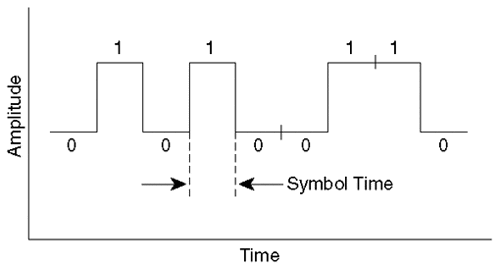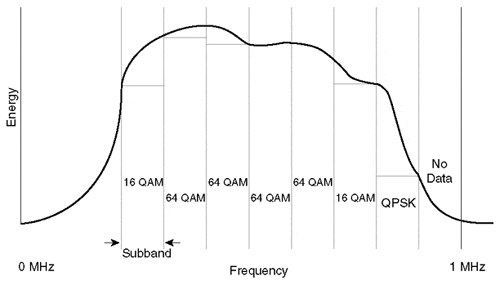Modulation Techniques
With that brief overview of the architectural elements of an RBB network, we now discuss some of the basic technology to make it all happen. We begin with the most basic problem of transmission: that of modulation technique.
Modulation techniques (also called line-coding techniques) are permutations of various properties of a constant waveform, such as amplitude, frequency, and phase, to encode uniqueness, which is, after all, information. Digital transmission through any medium (metal, fiber, or air) requires the use of modulation schemes to infuse digital information onto the medium. Modulation schemes differ as to speed of service they provide, quality of the medium they require, noise immunity, and complexity, which are proxies for cost. Even after decades of development, modulation is still a hotly debated issue among experts. Many incompatible schemes have developed, and research is still in process.
Some important modulation schemes used in existing systems are listed here:
On/Off Keying (OOK)
2B1Q
Quadrature Phase Shift Keying (QPSK)
Quadrature Amplitude Modulation (QAM)
Discrete Multitone (DMT)
The following sections discuss these schemes in greater detail.
On/Off Keying
On/Off keying (OOK) is an intuitively simple modulation scheme used in fiber optic transmission. When a sender wants to transmit a binary 1, the laser goes on (light is transmitted). For a binary 0, the laser is off. To transmit an arbitrary binary sequence, the transmitter simply turns its laser transmitter on and off, obviously very quickly. The time duration that the laser is on or off is called the symbol time (see Figure 2-4). The number of symbols per unit time is called the symbol rate. When symbol rates are very fast—on the order of billions of symbols per second—the important engineering problem of clock recovery arises to keep the sender and receiver synchronized. However, for relatively low symbol rates—measured in thousands or even millions per second—the current state-of-the-art fiber and electronics clock recovery permits reliable transmission.
Figure 2-4. On/Off Keying Example

The bit stream in Figure 2-4 conveys the bits 010100110.
2B1Q
In On/Off keying, one logical bit was conveyed per symbol. However, it is possible to convey more bits per symbol with variations in the symbol. For example, 2B1Q (2 binary, 1 quaternary) has four levels of amplitude (voltage) to encode two bits. Because there are four voltage levels, each level translates to two bits per symbol.
| Bits | Voltage Level (Amplitude) |
|---|---|
| 00 | +3 |
| 01 | +1 |
| 10 | –1 |
| 11 | –3 |
Figure 2-5's example conveys the 12 bits 110110001101 in six symbol times. Thus, two bits are transmitted for each symbol time. It is therefore possible to increase the bit rate of a wire or of a wireless channel either by increasing the symbol rate of the transmission (to make things go faster) or by increasing the number of bits per symbol (to make things smarter). Modulation schemes can be compared according to their spectral efficiency, or the measure of how many bits can be transmitted for a given amount of bandwidth.
Figure 2-5 . A 2B1Q Example

2B1Q is an amplitude modulation technique used for ISDN and high data rate digital subscriber line ( HDSL) service in the United States. It is defined in the 1988 ANSI spec T1.601.
2B1Q modulation produces two bits per symbol and hence can transmit twice the data of another modulation scheme that transmits one logical bit per symbol. If you want more bits per symbol, more voltage levels are needed. For example, to encode three bits per symbol time, you need eight voltage levels. To encode k bits per symbol time, you need 2 k voltage levels. However, as speed requirements increase, it becomes increasingly difficult for the receiver to discriminate among many voltage levels with consistent precision.
The limits on spectral efficiency of 2B1Q preclude its use with very high bit rates, including RBB applications such as video or high-speed data retrieval. However, 2B1Q has the advantage of being a well-understood modulation scheme that is relatively inexpensive and robust against the kind of interference observed in a telephone plant, where its use is very appropriate.
Quadrature Phase Shift Keying
Another aspect of the waveform, specifically phase, can also be modulated to encode information. The simplest form of phase modulation, which does not use any amplitude modulation, is phase shift keying (PSK). However, PSK is not commonly used because of its low spectral efficiency.
Quadrature phase shift keying (QPSK) transmits two waves with a common frequency, offset, by 90° , each of which is amplitude-modulated. QPSK achieves a modest spectral efficiency of two bits per symbol time and can operate in the harsh environments of over-the-air transmission and cable TV return paths. Because it is well understood, robust, and relatively low-cost, QPSK is widely used in modern systems, such as for direct broadcast satellite. It is also recommended for use on the return path in cable modem systems (discussed later in Chapter 3).
Quadrature Amplitude Modulation
QPSK is a special case of a more general technique called Quadrature Amplitude Modulation (QAM). Like QPSK transmission, two waves are involved: the I wave and the Q (or quadrature) wave. These are transmitted at the same frequency offset by 90°. As an example, one variant of QAM is QAM-64. With QAM-64, each of the waves is amplitude-modulated independently with eight levels of amplitude modulation, yielding 64 different amplitude levels jointly expressed by the two waves; hence the term QAM-64. The use of a quadrature wave and amplitude modulation give rise to the term quadrature amplitude modulation.
QAM can yield a higher spectral efficiency than 2B1Q. For example, with QAM-64, three bits are modulated on each carrier, thereby yielding six encoded bits per symbol. Cleaner lines (flat frequency response and high carrier/noise ratio) permit even more aggressive modulation. QAM-256 enables four bits to be encoded on each carrier, yielding eight bits per symbol. More aggressive modulation means more spectral efficiency (bits/symbol) and therefore more data per unit time on the medium.
Various flavors of QAM are referred to as QAM-nn, where nn is an integer indicating the number of states per symbol. The number of bits per symbol time is k, where 2k=nn. For example, if four bits per symbol are encoded, the result is QAM-16; six bits per symbol produces QAM-64. (You may also see the notation as 64-QAM, but we will use the prior notation.)
QAM is a well-known technique that has been used for years in analog phone modems (V.32 and V.34), where it was necessary to get a lot of bits through a relatively narrow voice grade telephone line. QAM-16 is proposed as an optional modulation scheme for return path data traffic on cable plants. The Society of Cable Television Engineers (SCTE) has specified the QAM-64 and QAM-256 modulation for digital video transmission over cable TV plants.
Other important modulation techniques similar to QAM are Vestigial Sideband (VSB), used in digital terrestrial television in the United States, and Carrierless Amplitude Modulation/Phase Modulation (CAP), used in ADSL modems, which is discussed in Chapter 4.
Figure 2-6 illustrates the QAM process. For ease of display, the I and Q waves are shown offset by half the frequency, or 180°. In actuality, the offset for QPSK and QAM is 90°, but that is a little more difficult to diagram.
Figure 2-6. QAM Modulation

Discrete Multitone
QPSK, QAM, and CAP are examples of modulation techniques that permute a single carrier (or two copies of a single wave, slightly offset from each other). These are called single-carrier techniques. Frequency, amplitude, and phase of the carrier can be modulated to encode information. These are well-understood techniques with a lot of industrial and defense experience behind them.
But with the development of digital signal processing (DSP), multicarrier techniques are now possible. Multicarrier techniques use an aggregate amount of bandwidth and divide it into subbands, thereby yielding multiple, parallel, narrower channels. Each subband is encoded using a single-carrier technique (such as QAM), and bit streams from the subbands are bonded together at the receiver. Important examples of multicarrier techniques include orthogonal frequency division multiplexing (OFDM) and discrete multitone (DMT).
Consider Figure 2-7, which shows an example of multicarrier modulation using the current ANSI T1.413 standard for ADSL. Here, 1 MHz is segmented into 256 subbands of 4 kHz each. The transmitter modulates each subband using a single-carrier modulation technique. The receiver accepts the subband and bonds the 256 carriers together.
OFDM and DMT differ in that OFDM uses a common modulation scheme for each subband. That is, each subband transfers the same number of bits per second. OFDM is used in European over-the-air broadcast digital television. In the case of over-the-air broadcast, all subbands are presumed to have uniform noise characteristics, so a common modulation technique makes sense.
DMT enhances the OFDM model by allowing variable spectral efficiency among the subbands. Some subbands can use more aggressive modulation schemes than other subbands. DMT is used in wired media such as ADSL, where the noise characteristics of each subband may differ. Subbands, which have high noise problems, can be avoided.
Figure 2-7. Multicarrier Modulation

Multicarrier techniques have a latency penalty (time delay to transmit a digital bit) compared with single carrier. In the DMT case for ADSL, there are 256 subbands of 4 kHz each. So no bit can travel faster than allowed by 4 kHz, even if the line was perfectly clean.
One of the noisiest debates about modulation techniques is between proponents of DMT and proponents of CAP for use in ADSL. DMT for ADSL uses 256 subbands, whereas CAP uses a single carrier with amplitude modulation, very similar to QAM. At the time of this writing, CAP has an advantage over DMT in that it consumes less power (thereby generating less heat) and costs less because it is more mature (more units in the field, greater integration). It is easy to see how DMT scales and why DMT has been selected by ANSI T1E1.4 and the International Telecommunications Union (ITU). Furthermore, a number of U.S. telephone companies have selected DMT. Because of these factors (and because of commercial issues with respect to the licensing of CAP), it appears DMT is gaining the upper hand for ADSL.
Considerations in Selecting Modulation Techniques
Selection of modulation technique for each Access Network has been highly contentious, partly because there's a lot of money at stake. Standards organizations for cable TV, xDSL, and HDTV have spent years arguing the requirements of modulation, let alone the choice. While commercial self-interest, academic background, national pride, embedded base and personal ego play a role, there are engineering and cost tradeoffs to consider as well.
Some of the majors engineering considerations are listed here:
Scale— Will the modulation support large systems and fast bit rates?
Noise immunity— Can the modulation scheme operate reliably in with real-world impairments?
Packaging— Can Application Specific Integrated Circuits (ASICs) be built? Can implementations be used in a variety of environments, such as different Access Networks? How large are the components, and how much power does the technique consume?
Performance— What is the spectral efficiency? What is the latency?
Cost— This is the dominant factor when dealing with consumer markets.
The modulation schemes described in this chapter are likely to be residential broadband alternatives. Table 2-2 lists services and their respective modulation schemes, current as of this writing.
| Service | Modulation Technique |
|---|---|
| ISDN (United States) | 2B1Q |
| U.S. Direct Broadcast Satellite | QPSK |
| U.S. Digital Over-the-Air Broadcast | Vestigial Sideband (VSB) |
| U.S. Digital Cable Forward Channels | QAM-64, QAM-256 |
| U.S. Digital Cable Return Channels | QPSK |
| European Digital Over-the-Air Broadcast | OFDM |
| High Bit Rate Digital Subscriber Line (HDSL) | 2B1Q |
| Asymmetric Digital Subscriber Line (ADSL) | DMT, CAP |
